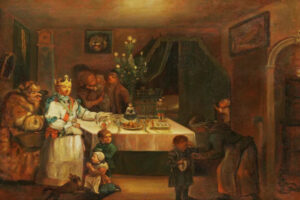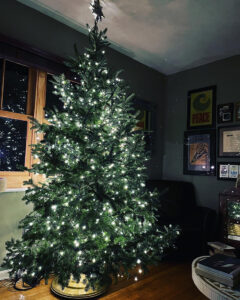
December: Month of Midwinter in the Northern Hemisphere, month of the first of the Midwinter gift bearers. Our own gift to you in this month of gift giving is the Convivio Book of Days calendar for December: a printable PDF, a fine companion to this blog, and yours free by clicking here. This month’s cover star is a circa 1760 oil painting by Nikolaus Hoffman called Weihnachtsbescherung, a nice long German word that translates to “Christmas Presents” in English. The presents in the painting are delivered by Christ the King, who is accompanied by Knecht Ruprecht. Old World gift bearers are often accompanied by a dark companion, and this is the role that Knecht Ruprecht plays: one deals with the good children, one with the not-so-good children.
You can experience a bit of this yourself if you come see us at one of our upcoming local pop-up Christmas markets: We’ll be at the local American German Club’s Krampusnacht celebration on the evening of Friday, December 9. It’s a good bit of spooky Midwinter fun that ushers in the club’s annual Christkindmarkt on Saturday the 10th and Sunday the 11th. Here’s a list of the Christmas Markets where you’ll find us for the month of December (afterwards, a bit of hibernation and our own Christmas preparations); before Krampusnacht, we’ll be at the German American Social Club’s Christmas Market in Miami this Saturday!
CHRISTMAS MARKET at the German American Social Club, Miami
Saturday December 3 from 10 AM to 5 PM. It’s our first pop-up shop in Miami! We’ll be at this inaugural Christkindlmarkt at the German American Social Club, 11919 SW 56 Street, Miami 33175. Don’t let the “inaugural” fool you: The German American Social Club is home to Florida’s oldest Oktoberfest celebration, so they know what they’re doing! We’re looking forward to joining in the festivities. Admission is free, but you must register ahead of time to reserve your spot, as there are a limited number of tickets. Click here for the details.
KRAMPUSNACHT at the American German Club, Lake Worth
Friday December 9 from 7 to 11 PM. This spooky fun event at the American German Club on West Lantana Road kicks off the club’s annual Christkindlmarkt. We’ll be there with our largest pop-up shop ever. Tickets required, and they always sell out, so buy them early! Click here for full details.
CHRISTKINDLMARKT at the American German Club, Lake Worth
Saturday December 10 from 2 to 10 PM & Sunday December 11 from Noon to 8 PM. The two days following Krampusnacht at the American German Club on West Lantana Road brings their beautiful annual Christkindlmarkt and we will be there with our largest booth ever. Tickets are required, and this event always sells out, too, so buy your tickets early. Click here for full details.
CHRISTMAS AROUND THE WORLD at Johan’s Jöe in Downtown West Palm Beach
We’re collaborating with our favorite Swedish coffee house in Downtown West Palm Beach for a special 3-day Christmas pop-up shop: Friday December 16 from about 10 AM to 4 PM, and then Saturday December 17 & Sunday December 18 from about 7 AM to 4 PM each day. Johan’s will have their usual delicious menu plus lots of Nordic pantry staples along with bottled wine specials, and we’ll have three tables featuring some of our best Christmas items from Sweden, Germany, and Mexico. Johan’s Jöe is located at 401 South Dixie Highway. Everything there is delicious and my mom and my niece love the big purple chairs.
JOYFUL SALE at our online shop
And at our online shop, all through Advent and Christmastime: use discount code JOYFUL at checkout for $10 off your purchase of $85, plus get free domestic shipping. And if you think it’ll be difficult to spend $85 at our website, you’ve probably not stopped by in a long while. We add new items every week lately and I think you’ll be pleased with the variety you’ll find. If you’re local, order and choose the Local Free Delivery option if you’re in the coastal Lake Worth, Lantana, or West Palm Beach area, and I’ll bring your order to you myself (by vintage Raleigh bicycle if you’re in my neighborhood). Click here to shop!
Image: “Weihnachtsbescherung” by Nikolaus Hoffmann. Oil on canvas, circa 1760 [Public domain via Wikimedia Commons].


